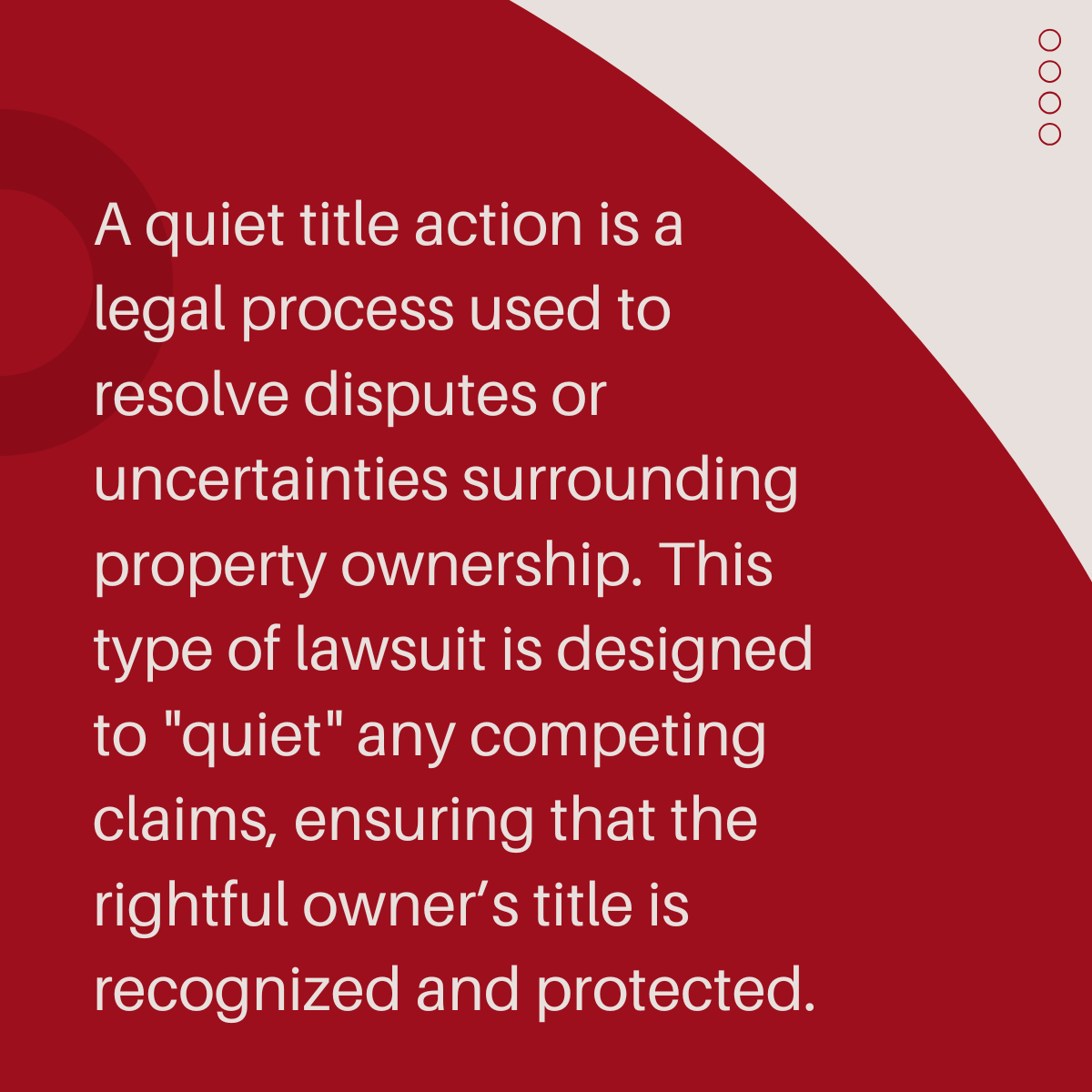
How to be Successful in Quiet Title Action
*THE INFORMATION INCLUDED IN THIS BLOG POST IS FOR INFORMATIONAL PURPOSES ONLY AND DOES NOT CONSTITUTE ADVERTISING, A SOLICITATION, OR LEGAL ADVICE, AND SHOULD NOT REPLACE YOUR CONSULTATION WITH A LAWYER CONCERNING YOUR PARTICULAR NEEDS*
Property ownership disputes can be challenging, often leaving individuals unsure about the next steps to take. Whether it’s due to unclear deeds, inheritance issues, or conflicting claims, resolving these disputes may need a legal approach called a quiet title action.
Understanding the steps involved and having the right legal strategy are key to achieving your goals. In this blog, we’ll explore some of the actions that might typically help you to be successful in quiet title actions, focusing on some of the essential steps, common challenges, and how expert legal assistance can make a significant difference.
What Is Quiet Title Action?
A quiet title action is a legal process used to resolve disputes or uncertainties surrounding property ownership. This type of lawsuit is designed to “quiet” any competing claims, ensuring that the rightful owner’s title is recognized and protected. By filing a quiet title action, property owners can clear up issues such as ownership disputes, claims from previous owners, or errors in public records.
In California, quiet title actions are important due to the state’s property laws and the prevalence of disputes involving inherited properties, boundary lines, and liens. For anyone facing ownership issues, pursuing a quiet title case in California can provide legal clarity and peace of mind, ultimately securing their rights to the property.

Common Scenarios Requiring Quiet Title Action
Below are some of the most common scenarios where pursuing a quiet title action is important.
Disputes Over Property Boundaries
Boundary disputes frequently occur when property lines are unclear or when neighboring landowners rely on conflicting surveys or deeds. For instance, if a fence or structure encroaches on what one party believes is their property, a quiet title action can establish the precise boundary. This legal resolution helps eliminate confusion and prevent future disagreements.
Unclear Ownership Due to Inheritance or Outdated Records
Properties passed down through generations or purchased decades ago can have ownership complications due to missing documents or outdated records. In some cases, multiple heirs may claim the same property, or old deeds may not reflect current ownership. Quiet title actions help resolve these silent title issues, providing clarity and securing legal ownership.
Resolving Liens or Encumbrances
Liens, easements, or other encumbrances can impact a property’s value and usability. For example, a lien from an unpaid debt or a right-of-way easement might restrict the owner’s ability to sell or develop the property. By filing a quiet title action, these claims can be legally addressed and removed, ensuring the title is free and clear.
Whether it’s an inherited property with murky history or a boundary disagreement with a neighbor, a quiet title action is a powerful tool for securing property rights and resolving conflicts.

Source: Freepik
Common Steps that can Help You to be Successful in a Quiet Title Action
Successfully resolving property disputes requires careful planning and strict adherence to legal procedures. Here are a few of the essential actions that should be taken when pursuing a quiet title action. The experienced attorneys at DMAB are available to help you through the steps identified below and all of the necessary actions that should be taken when pursuing a quiet title action.
1. Understand the Legal Requirements
When pursuing a quiet title action in California, it is critical to be familiarized with California’s specific quiet title action requirements. This process includes, among other things, adhering to strict timelines, notifying all interested parties, and filing in the correct court. Accurate and complete documentation, including deeds, surveys, and prior legal filings, is critical to meet these requirements. Missing or incomplete paperwork can delay your case or even lead to dismissal.
2. Conduct a Thorough Title Search
A detailed title search is important as this step can help uncover competing claims, unresolved liens, or historical discrepancies that might cloud title to property. Addressing these issues proactively can strengthen your case. In some cases, a “quiet claim” may be used to clear minor discrepancies or remove claims that parties no longer contest.
3. File the Quiet Title Action Properly
Once the necessary information is gathered, and the issue is not resolved outside of court, the next step will generally be to file the action in a California court. Among other necessary requirements, it is critical that the filing includes all relevant parties who might have a claim to the property. This will help ensure that the court can issue a comprehensive judgment. Missing a stakeholder can prolong the process and require additional filings. Proper legal representation during this step can help avoid costly errors.
4. Gather Evidence and Build a Strong Case
Presenting clear and convincing evidence of ownership is crucial to a successful quiet title action. Key documents such as property deeds, purchase contracts, tax records, and historical documents will help establish proof of ownership. These records must align with the legal requirements to demonstrate an unbroken chain of ownership.
5. Navigate Court Procedures and Hearings
Quiet title actions involve court procedures and may require hearings to resolve disputes. An experienced attorney can manage these processes efficiently, ensuring that all filings, notifications, and presentations to the court are handled correctly. Having legal representation also increases the likelihood of achieving a favorable outcome, as attorneys can address complex arguments and counterclaims.
By working with experienced legal professionals, you can navigate the quiet title action process confidently and effectively.

Why Legal Expertise Matters in Quiet Title Cases
Risks of Self-Representation in Quiet Title Cases
Self-representation in quiet title actions can be risky, especially if you’re unfamiliar with property laws or court procedures. Missing important deadlines, failing to notify all interested parties, or providing incomplete documentation can result in delays, additional expenses, or even losing your case.
How Experienced Attorneys Can Increase Your Chance of Success
Experienced attorneys bring a deep understanding of quiet title laws and procedures. They can conduct thorough title searches, identify potential issues, and present compelling evidence to support your claim. Lawyers also handle court hearings and negotiations, reducing your stress and increasing the likelihood of a favorable outcome.
Contact us Today
Quiet title actions can help resolve property disputes and establish clear ownership. Whether you’re facing boundary disagreements, unclear inheritance claims, or unresolved liens, following the correct steps is essential. However, the nuances of quiet title cases make legal expertise invaluable. An experienced attorney can guide you through the process, ensure compliance with state laws, and significantly improve your chances of success.
At DMAB, our experienced attorneys can help ensure that your case is handled with care, expertise, and managed appropriately from start to finish. Contact us today for a consultation.
